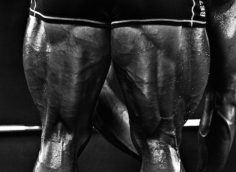I'm always experimenting in the gym. Hell, I sometimes think if I didn't spend so much time trying new ways to train that I'd be a lot further ahead, physique-wise. Usually, I'm trying to assess some new type of machine, or trying to figure out how effective it is to move my arms or legs just so. Sometimes, I luck out and tap into some incredible neuro-muscular groove and training gets exciting again, almost like new love or something. Other times, I try something new and the experience is a lot like the time my mom forced me to try an unholy ethnic dish of liver, raisins, and rice that she had somehow inherited from her Finnish roots. In short, I get disgusted and training becomes a real chore.
Already a T Nation+ Member? Log in
You haven’t completed your membership signup
Your T Nation+ membership has expired
Get instant access to this content
Become a T Nation+ member and get immediate access to all of our member-only videos, articles, coaching groups and more.
Click here to learn more about T Nation+Click here to complete the signup processClick here to renew your membership
This time, I stumbled on a training program that's both different and effective. I call it, for lack of a better term, the "Oscillating Wave Program." Most weight-training workouts fit into one of three categories. The first category is a strength-training program where the goal is to increase the maximum amount of weight you can lift. The second is a typical bodybuilding, or hypertrophy, program where your main interest is in making your muscles grow larger. And the third category is a muscular endurance phase where you both increase the muscles' ability to do aerobic work while burning up some calories at the same time.
All three of these workouts are typically characterized by specific traits. Strength-building workouts are characterized by doing sets of less than six reps and taking lots of rest in between sets. Hypertrophy training normally consists of doing sets of 8 to 12 reps with a moderate amount of rest. And lastly, endurance training is typically characterized by a high number of reps and very short rest periods.
However, what if you combined all three types of workout in one?
Maybe you think this sounds gimmicky, but hear me out; there appears to be a fairly large amount of research that supports doing this type of program.
Look at it this way; in any training program, the body typically responds in three different "phases." The first phase is shock. The body is confronted with a new style of training. Soreness develops and performance temporarily tanks. The second phase is adaptation to the new stimulus and performance increases. Unfortunately, the third phase is staleness. No further adaptations take place because the body's used to the program.
To remedy this, most coaches and strength trainers in the know recommend altering training intensity and training volume by switching to an entirely different type of program. The "Oscillating Wave Program" does both on a daily basis.
Before I try to explain more of the method behind my seeming madness, I'll describe what I've come up with. Don't worry if it doesn't make sense right away, I've included an easy-to-follow chart later on.
In essence, we're going to do a five-day split where day one is devoted to biceps, triceps, and shoulders. Day two is devoted to legs, while day three is an off day. It's back to the gym on day four to work chest and back, while day five is another off day. Then, it's time to start the split all over again with biceps, triceps, and shoulders.
Easy enough. Nothing revolutionary there. However, what I've done is to use three varying rep schemes, three varying tempos, and three varying rest periods, all in the same five-day split. For instance, the first bi/tri/shoulder workout is devoted to strength training. The reps are very low (3 to 6), the tempo is slow (3121), and the rest periods are long (at least 120 seconds).
The next workout, on the very next day, legs, is devoted to hypertrophy training. The reps are moderate (8 to 12), as is the tempo (2020), and the rest periods (90 seconds).
The third workout, done after a day of rest, is for chest and back. This particular workout is devoted to endurance training. The reps are high (15-20), the tempo is explosive (10X0), and the rest periods are short (60 seconds).
After taking another day off, the split starts all over again, but this time, you're going to do hypertrophy training for the shoulders and arms (8 to 12 reps), endurance training for the legs (15 to 20 reps), and strength training for the chest and back (3 to 6 reps).
You continue to vary the type of training for each body part with each successive five-day training split. To look at it another way, the first time you train arms and shoulders, you're doing low-rep (3 to 6) strength training. The next time you train arms and shoulders, just a few days later, you're doing moderate-rep (8 to 12) hypertrophy training. The third time you train arms and shoulders, you're doing high-rep (15 to 20) endurance training. After that, you start the whole cycle over again with low-rep training.
Each of the body parts gets subjected to this type of round-robin training. You never use the same rep range for the same body part twice in a row. Furthermore, you never do two workouts of any kind in succession using the same rep ranges.
To make it easier to understand, take a look at the following chart:
Day 1: Biceps, triceps, and shoulders
Reps: 3-6
Tempo: 3121*
Rest: 120
Day 2: Legs
Reps: 8-12
Tempo: 2020
Rest: 90
Day 3: Off
Day 4: Chest and back
Reps: 15-20
Tempo: 10X0
Rest: 60
Day 5: Off
Day 6: Biceps, triceps, and shoulders
Reps: 8-12
Tempo: 2020
Rest: 90
Day 7: Legs
Reps: 15-20
Tempo: 10X0
Rest: 60
Day 8: Off
Day 9: Chest and back
Reps: 3-6
Tempo: 3121
Rest: 120
Day 10: Off
Day 11: Biceps, triceps, and shoulders
Reps: 15-20
Tempo: 10X0
Rest: 60
Day 12: Legs
Reps: 3-6
Tempo: 3121
Rest: 120
Day 13: Off
Day 14: Chest and back
Reps: 8-12
Tempo: 2020
Rest: 90
*For those of you who aren't used to seeing "tempo" at the top of your workout sheets, it refers to how fast you should do the movement. The first number means how many seconds you should take to do the eccentric, or lowering, part of the movement. The second number refers to how long of a pause—if any—you should take before raising the weight. The third number refers to how many seconds it should take to raise the weight. And the last number refers to the duration of the pause you should take before starting the next rep. The designation "X" means you should lift the weight as fast as possible.
In effect, this program is not only a periodization program, it's an ultra-periodization program where you vary the number of sets, the number of reps, and the resistance, all in one week.
NOTE: I thought about recommending a specific number of exercises and sets, but I felt that might make it a little too confusing. Suffice it to say that there's a direct correlation between intensity and volume. In other words, if you're doing sets where the rep ranges are close to your 1RM, the more sets you need to do. In contrast, when you do sets of higher rep ranges, the fewer sets you need to do. So, on those days where you're doing rep ranges from 3 to 6, you might need to do a few more total sets to get the desired training effect. On those days where you're doing high-rep sets of 15 to 20, you can get away with doing fewer total sets. And, as you might guess, the optimum total number of sets for hypertrophy training (sets of 8 to 12 reps) is in the middle.
There are at least a couple of reasons why the "Oscillating Wave Program" might be very effective:
• Skeletal muscle is a heterogeneous mixture of several types of muscle fibers, each specifically designed for a specific use. Type II fibers are recruited in the performance of high-intensity, short-duration bouts of work as typified by 1RM-lifts or sets of low reps. Type I fibers are recruited for endurance bouts, typified by aerobic activity or long sets of exercise. The use of heavy, moderate, and light resistances in training, however, would allow specific muscle fibers to rest by not taxing them on successive workouts.
• Different rep ranges elicit different hormonal responses (Kraemer, et al. 1993). The highest GH and beta-endorphin concentrations seem to occur with mid-range rep ranges (about ten) and short rest periods. Testosterone increases, however, occur during both low-rep range (about five) workouts with long rest periods (about three minutes) and moderate-range (about ten reps), short rest-period workouts. It seems that using different rep ranges frequently might accentuate the hormonal response.
There's another real good reason you might want to try the "Oscillating Wave Program." It works. I'm making bigger jumps in strength from workout to workout than I can remember making in the last few years (it's crucial that you keep a training log, though, so that you can compare from like-workout to like-workout). Furthermore, I haven't gotten bored and that's really saying something. In fact, it might be a long time before I feel the urge to experiment again.




